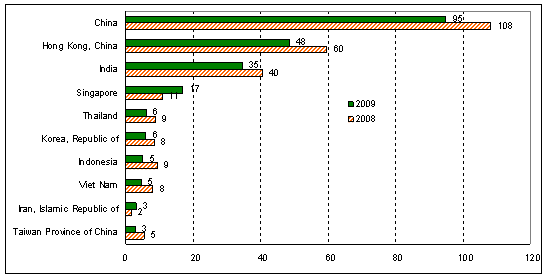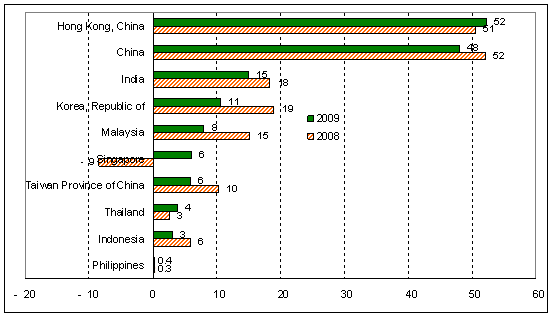| EMBARGO The contents of this press release and the related Report must not be quoted or summarized in the print, broadcast or electronic media before 22 July 2010,17:00 [GMT] (13:00 New York; 19:00 Geneva, 22:30 New Delhi, 02:00 - 23 July 2010 Tokyo) |
Geneva, 22 July 2010 - Foreign direct investment (FDI) to South, East, and South-East Asia has been less affected by the global financial and economic crisis and is the first to break out of the downturn, says UNCTAD´s World Investment Report 2010(1). Recovery in FDI in the region has been stronger than that in other parts of the world: it started as early as mid-2009, and gained momentum early this year. Inflows to the region as a whole are likely to rebound in 2010 and continue to grow in 2011, the report says. FDI outflows from the region are also expected to rebound, it notes.
Quarterly data show that FDI inflows have already started rebounding and are expected to pick up speed (table 1). South, East, and South-East Asia remains a priority investment destination: the recovery in inflows has been led by investment into China and India - the two largest emerging economies. FDI recovery in the region´s four newly industrializing economies (NIEs - Hong Kong (China), Republic of Korea, Singapore, and Taiwan Province of China) is slower and more muted, the report notes.
Compared to FDI inflows to other parts of the world, those to South, East, and South-East Asia were less affected by the crisis: they dropped by a modest 17% to $233 billion in 2009. The region´s relatively strong performance has helped reshape the global FDI landscape: this part of Asia now accounts for one fifth of FDI inflows worldwide. Its top three FDI recipients - China, Hong Kong (China), and India (figure 1) - rank numbers two, four, and nine, respectively, in the world for incoming FDI.
A drop in cross-border mergers and acquisitions (M&As) was largely responsible for the overall decline in FDI inflows to the region in 2009. The value of M&A sales totalled $35 billion in 2009, down 34% from 2008. In the four NIEs, the value of cross-border M&As plummeted by 44%. Although the decline was less pronounced, "greenfield" investment - that is, new, from-the-ground-up ventures begun by transnational corporations (TNCs) in foreign countries - also slowed, as some projects were cancelled or postponed. And some divestments took place, accelerating the decline.
In 2009, outflows from the region dropped by only 8%, to $153 billion. Although total FDI outflows declined, non-financial FDI flows from China continued to expand, driven by a persistent pursuit of natural resources and M&A opportunities generated by global industrial restructuring. Leading sovereign wealth funds, especially the China Investment Corporation (CIC), remain on a buying spree, although they appear to have changed their investment focus from financial services to manufacturing and mineral assets.
Due to weakened investment from developed countries, intraregional FDI gained ground (it now accounts for as much as half of the region´s inward FDI stock). Growing intraregional investment has served as a vehicle for "recycling" comparative advantages, transferring technology, and enhancing competitiveness in South, East, and South-East Asia. It has been instrumental in the sequential upgrading of industries across countries at various stages of development. In recent years, regional integration has accelerated this process, encompassing more production activities and creating development opportunities for a wider range of countries, including such least developed countries as Cambodia, the Lao People´s Democratic Republic, and Myanmar.
In 2009, the great majority of investment policy measures in the region aimed at promoting foreign investment, although new restrictions, such as bans from engaging in certain activities or tightened screening processes, were introduced. In countries such as China and India, efforts to attract foreign investment have sometimes focused on new or high value-added industries. A number of countries (for example, Sri Lanka and Thailand) eased conditions for outward FDI through the simplification of foreign-exchange regulations.
The World Investment Report and its database are available online at http://www.unctad.org/wir and http://www.unctad.org/fdistatistics and http://www.unctad.org/diae |
ANNEX
Tables and figures
Table 1. FDI flows of selected economies in South, East, and South-East Asia, 2009-2010, by quarter (Millions of dollars)
Source: UNCTAD, World Investment Report 2010.
Note:a FDI flows in non-financial sectors.
Figure 1. South, East and South-East Asia: top 10 recipients and sources of FDI flows,a 2008-2009 (Billions of dollars)

b) FDI outflows

Source: UNCTAD, World Investment Report 2010.
Note: a Ranked on the basis of the magnitude of 2009 FDI flows.


